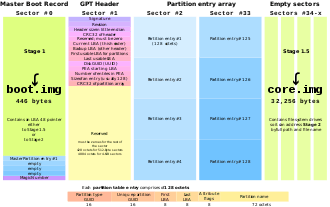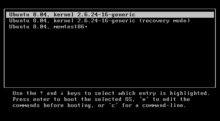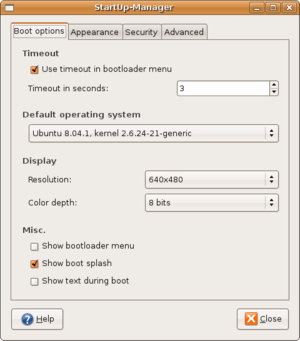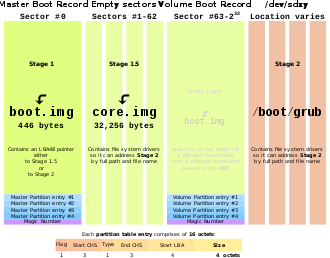GNU GRUB
  | |
.png) GRUB v2 running in text mode | |
| Original author(s) | Erich Boleyn |
|---|---|
| Developer(s) | GNU Project |
| Initial release | 1995 |
| Stable release | |
| Preview release | |
| Repository |
|
| Written in | Assembly, C[3] |
| Operating system | Linux, macOS, BSD, Solaris (x86 port) and Windows (through chainloading) |
| Platform | IA-32, x86-64, IA-64, ARM, PowerPC, MIPS and SPARC |
| Available in | English and others |
| Type | Bootloader |
| License | GNU GPL version 3[4] |
| Website |
www |
GNU GRUB (short for GNU GRand Unified Bootloader) is a boot loader package from the GNU Project. GRUB is the reference implementation of the Free Software Foundation's Multiboot Specification, which provides a user the choice to boot one of multiple operating systems installed on a computer or select a specific kernel configuration available on a particular operating system's partitions.
GNU GRUB was developed from a package called the Grand Unified Bootloader (a play on Grand Unified Theory[5]). It is predominantly used for Unix-like systems. The GNU operating system uses GNU GRUB as its boot loader, as do most Linux distributions and the Solaris operating system on x86 systems, starting with the Solaris 10 1/06 release.
Operation

Booting
When a computer is turned on, BIOS finds the configured primary bootable device (usually the computer's hard disk) and loads and executes the initial bootstrap program from the master boot record (MBR). The MBR is the first sector of the hard disk, with zero as its offset (sectors counting starts at zero). For a long time, the size of a sector has been 512 bytes, but since 2009 there are hard disks available with a sector size of 4096 bytes, called Advanced Format disks. As of October 2013, such hard disks are still accessed in 512-byte sectors, by utilizing the 512e emulation.[6]
The legacy MBR partition table supports a maximum of four partitions and occupies 64 bytes. Together with the optional disk signature (four bytes) and disk timestamp (six bytes), this leaves between 434 and 446 bytes available for the machine code of a boot loader. Although such a small space can be sufficient for very simple boot loaders,[7] it is not big enough to contain a boot loader supporting complex and multiple file systems, menu-driven selection of boot choices, etc. Boot loaders with bigger footprints are thus split into pieces, where the smallest piece fits into and resides within the MBR, while larger piece(s) are stored in other locations (for example, into empty sectors between the MBR and the first partition) and invoked by the boot loader's MBR code.
Operating system kernel images are in most cases files residing on appropriate file systems, but the concept of a file system is unknown to the BIOS. Thus, in BIOS-based systems, the duty of a boot loader is to access the content of those files, so it can be loaded into the RAM and executed.
One possible approach for boot loaders to load kernel images is by directly accessing hard disk sectors without understanding the underlying file system. Usually, an additional level of indirection is required, in form of maps or map files – auxiliary files that contain a list of physical sectors occupied by kernel images. Such maps need to be updated each time a kernel image changes its physical location on disk, due to installing new kernel images, file system defragmentation etc. Also, in case of the maps changing their physical location, their locations need to be updated within the boot loader's MBR code, so the sectors indirection mechanism continues to work. This is not only cumbersome, but it also leaves the system in need of manual repairs in case something goes wrong during system updates.[8]
Another approach is to make a boot loader aware of the underlying file systems, so kernel images are configured and accessed using their actual file paths. That requires a boot loader to contain a driver for each of the supported file systems, so they can be understood and accessed by the boot loader itself. This approach eliminates the need for hardcoded locations of hard disk sectors and existence of map files, and does not require MBR updates after the kernel images are added or moved around. Configuration of a boot loader is stored in a regular file, which is also accessed in a file system-aware way to obtain boot configurations before the actual booting of any kernel images. As a result, the possibility for things to go wrong during various system updates is significantly reduced. As a downside, such boot loaders have increased internal complexity and even bigger footprints.[8]
GNU GRUB uses the second approach, by understanding the underlying file systems. The boot loader itself is split into multiple stages, allowing for itself to fit within the MBR boot scheme.
Two major versions of GRUB are in common use: GRUB version 1, called GRUB legacy, is only prevalent in older releases of Linux distributions, some of which are still in use and supported, for example CentOS 5. GRUB 2 was written from scratch and intended to replace its predecessor, and is now used by a majority of Linux distributions.
Version 1 (GRUB legacy)

The master boot record (MBR) usually contains GRUB stage 1, but can contain another bootloader which can chain boot GRUB stage 1 from another boot sector such as a partition's volume boot record. Given the small size of a boot sector (512 bytes), stage 1 can do little more than load the next stage of GRUB by loading a few disk sectors from a fixed location near the start of the disk (within its first 1024 cylinders).
Stage 1 can load stage 2 directly, but it is normally set up to load the stage 1.5., located in the first 30 KiB of hard disk immediately following the MBR and before the first partition. In case this space is not available (unusual partition table, special disk drivers, GPT or LVM disk) the install of stage 1.5 will fail. The stage 1.5 image contains file system drivers, enabling it to directly load stage 2 from any known location in the filesystem, for example from /boot/grub. Stage 2 will then load the default configuration file and any other modules needed.
Version 2 (GRUB)

boot.img has the exact size of 446 bytes and is written to the MBR (sector 0). core.img is written to the empty sectors between the MBR and the first partition, if available (for legacy reasons the first partition starts at sector 63 instead of sector 1, but this is not mandatory). The /boot/grub directory can be located on a distinct partition, or on the root partition.- Stage 1:
boot.imgis stored in the master boot record (MBR) or optionally in any of the volume boot records (VBRs), and addresses the next stage by an LBA48 address (thus, the 1024-cylinder limitation of GRUB legacy is avoided); at installation time it is configured to load the first sector ofcore.img. - Stage 1.5:
core.imgis by default written to the sectors between the MBR and the first partition, when these sectors are free and available. For legacy reasons, the first partition of a hard drive does not begin at sector 1 (counting begins with 0) but at sector 63, leaving 62 sectors of empty space not part of any partition or file system, and therefore not prone to any problems related with it. Once executed,core.imgwill load its configuration file and any other modules needed, particularly file system drivers; at installation time, it is generated fromdiskboot.imgand configured to load the stage 2 by its file path. - Stage 2: files belonging to the stage 2 are all held in
/boot/grub, which is a subdirectory of the/bootdirectory specified by the Filesystem Hierarchy Standard (FHS).
Once GRUB stage 2 has loaded, it presents a text-based user interface (TUI)-based operating system selection (kernel selection) menu, where the user can select which operating system to boot. GRUB can be configured to automatically load a specified kernel after a user-defined timeout; if the timeout is set to zero seconds, pressing and holding ⇧ Shift while the computer is booting makes it possible to access the boot menu.[9]
If files or the partition become unavailable, or if the user wishes to take direct control, stage 2 will drop the user to the GRUB command prompt, where the user can then manually specify the boot parameters.
In the operating system selection menu GRUB accepts a couple of commands:
- By pressing e, it is possible to edit parameters for the selected operating system before the operating system is started. Typically, this is used to change kernel parameters for a Linux system. The reason for doing this in GRUB (i.e. not editing the parameters in an already booted system) can be an emergency case: the system has failed to boot. Using the kernel parameters line it is possible, among other things, to specify a module to be disabled (blacklisted) for the kernel. This could be required if the specific kernel module is broken and thus prevents boot-up. For example, to blacklist the kernel module
nvidia-current, one could appendmodprobe.blacklist=nvidia-currentat the end of the kernel parameters. - By pressing c, the user enters the GRUB command line. The GRUB command line is not a regular Linux shell, like e.g. bash, and accepts only certain GRUB-specific commands, documented by various Linux distributions.[10]
Once boot options have been selected, GRUB loads the selected kernel into memory and passes control to the kernel. Alternatively, GRUB can pass control of the boot process to another boot loader, using chain loading. This is the method used to load operating systems such as Microsoft Windows, that do not support the Multiboot Specification or are not supported directly by GRUB.
History
GRUB was initially developed by Erich Boleyn as part of work on booting the operating system GNU/Hurd, developed by the Free Software Foundation.[11] In 1999, Gordon Matzigkeit and Yoshinori K. Okuji made GRUB an official software package of the GNU Project and opened the development process to the public.[11] As of 2014, the majority of Linux distributions have adopted GNU GRUB 2, as well as other systems such as Sony's PlayStation 4.[12]
Development
GRUB version 1 (also known as "GRUB Legacy") is no longer under development and is being phased out.[13] The GNU GRUB developers have switched their focus to GRUB 2,[14] a complete rewrite with goals including making GNU GRUB cleaner, more robust, more portable and more powerful. GRUB 2 started under the name PUPA. PUPA was supported by the Information-technology Promotion Agency (IPA) in Japan. PUPA was integrated into GRUB 2 development around 2002, when GRUB version 0.9x was renamed GRUB Legacy.
Some of the goals of the GRUB 2 project include support for non-x86 platforms, internationalization and localization, non-ASCII characters, dynamic modules, memory management, a scripting mini-language, migrating platform specific (x86) code to platform specific modules, and an object-oriented framework. GNU GRUB version 2.00 was officially released on June 26, 2012.[15][16]
Three of the most widely used Linux distributions use GRUB 2 as their mainstream boot loader.[17][18][19] Ubuntu adopted it as the default boot loader in its 9.10 version of October 2009.[20] Fedora followed suit with Fedora 16 released in November 2011.[21] OpenSUSE adopted GRUB 2 as the default boot loader with its 12.2 release of September 2012.[22] Solaris also adopted GRUB 2 on the x86 platform in the Solaris 11.1 release.[23]
In late 2015 the exploit of pressing backspace 28 times to bypass the login password was found and quickly fixed.[24][25]
Variants
GNU GRUB is free and open-source software, so several variants have been created. Some notable ones, which have not been merged into GRUB mainline:
- OpenSolaris includes a modified GRUB Legacy that supports BSD disklabels, automatic 64-bit kernel selection, and booting from ZFS (with compression and multiple boot environments).[26][27]
- Google Summer of Code 2008 had a project to support GRUB legacy to boot from ext4 formatted partitions.[28]
- The Syllable project made a modified version of GRUB to load the system from its AtheOS File System.[29]
- TrustedGRUB extends GRUB by implementing verification of the system integrity and boot process security, using the Trusted Platform Module (TPM).[30]
- The Intel BIOS Implementation Test Suite (BITS) provides a GRUB environment for testing BIOSes and in particular their initialization of Intel processors, hardware, and technologies. BITS supports scripting via Python, and includes Python APIs to access various low-level functionality of the hardware platform, including ACPI, CPU and chipset registers, PCI, and PCI Express.[31]
Utilities
GRUB configuration tools

The setup tools in use by various distributions often include modules to set up GRUB. For example, YaST2 on SUSE Linux and openSUSE distributions and Anaconda on Fedora/RHEL distributions. StartUp-Manager and GRUB Customizer are graphical configuration editors for Debian-based distributions.
For GRUB 2 there are KDE Control Modules.[32][33]
GRLDR ICE is a tiny tool for modifying the default configuration of grldr file for GRUB4DOS.[34]
Other utilities
GRUB Utilities is a collection of multi-platform utilities for GRUB Legacy, GRUB 2 and GRUB for DOS.[35]
Boot-Repair is a simple graphical tool for recovering from frequent boot-related problems with GRUB and Microsoft Windows bootloader. This application is available under GNU GPL license. Boot-Repair can repair GRUB on multiple Linux distributions including, but not limited to, Debian, Ubuntu, Mint, Fedora, openSUSE, and Arch Linux.[36]
Grub2Win is a software package that enables GNU Grub to boot from a Windows directory. The GNU Grub version 2.02 code is installed to a Windows NTFS partition. A Windows GUI application is used to customize the Grub boot menu, themes, scripts etc. All GNU Grub scripts and commands are supported for both UEFI and legacy systems. Grub2Win can configure Grub for Ubuntu, openSuse, Fedora and many other Linux distributions. It is available under GNU GPL License at SourceForge.
See also
References
- ↑ Serbinenko, Vladimir (April 26, 2017). "GRUB 2.02 release". grub-devel (Mailing list). Retrieved April 27, 2017.
- ↑ ftp://alpha.gnu.org/gnu/grub/
- ↑ "Ohloh Analysis Summary – GNU GRUB". Ohloh. Retrieved 2010-05-12.
- ↑ "GNU GRUB license". Archived from the original on 2013-09-11.
- ↑ EnterpriseLinux.com Definitions Definition of GRand Unified Bootloader
- ↑ Smith, Ryan (December 18, 2009). "Western Digital's Advanced Format: The 4K Sector Transition Begins". AnandTech. Retrieved October 10, 2013.
- ↑ "mbldr (Master Boot LoaDeR)". mbldr.SourceForge.net. 2009. Retrieved October 10, 2013.
- 1 2 "Booting and Boot Managers". SuSE. Retrieved 2013-10-10.
- ↑ Hoffman, Chris (September 22, 2014). "How to Configure the GRUB2 Boot Loader's Settings". HowToGeek.com.
- ↑ "GNU GRUB documentation".
- 1 2 GRUB Manual – 1.2 Grub History. Gnu.org (2012-06-23). Retrieved on 2012-12-01.
- ↑ "PS4 runs Orbis OS, a modified version of FreeBSD that's similar to Linux". extremetech.com. 2013-06-24. Retrieved 2013-10-23.
- ↑ GNU GRUB – GRUB Legacy. Gnu.org. Retrieved on 2012-12-01.
- ↑ "GNU GRUB – GRUB 2". Archived from the original on June 7, 2008. Retrieved April 18, 2014. .
- ↑ Serbinenko, Vladimir (June 28, 2012). "GRUB 2.00 released". grub-devel (Mailing list). Retrieved December 1, 2012.
- ↑ Larabel, Michael. "GRUB 2.00 Boot-Loader Officially Released". Phoronix.com. Retrieved 28 June 2012.
- ↑ Haddon, Tom (January 26, 2012). "An Introduction to Ubuntu". WebJunction. Archived from the original on October 28, 2012. Retrieved September 21, 2012.
- ↑ Janssen, Cory. "What is Red Hat Enterprise Linux (RHEL)?". Technopedia. Retrieved 21 September 2012.
- ↑ Varghese, Sam (2012-09-20). "SUSE chief lists progress since privatisation". Retrieved 21 September 2012.
- ↑ "9.10 Karmic GRUB version". Distrowatch.com. Retrieved 8 July 2012.
- ↑ GRUB 2. FedoraProject. Retrieved on 2012-12-01.
- ↑ openSUSE:Upcoming features – openSUSE Archived September 20, 2012, at the Wayback Machine.. En.opensuse.org. Retrieved on 2012-12-01.
- ↑ Solaris 11.1. Oracle Retrieved 2015-03-19.
- ↑ Khandelwal, Swati (December 16, 2015). "You can Hack into a Linux Computer just by pressing 'Backspace' 28 times". thehackernews.com.
- ↑ Marco and, Hector; Ripoll, Ismael (December 2015). "Back to 28: Grub2 Authentication 0-Day".
- ↑ x86: Modifying Boot Behavior by Editing the GRUB Menu at Boot Time Archived July 19, 2011, at the Wayback Machine., Modifying Solaris Boot Behavior on x86 Based Systems (Task Map) – System Administration Guide: Basic Administration
- ↑ x86: Supported GRUB Implementations Archived October 21, 2009, at the Wayback Machine., (System Administration Guide: Basic Administration) – Sun Microsystems
- ↑ >Peng, Tao. "Grub4ext4". Retrieved June 13, 2017.
- ↑ 2.3 Why does Syllable have its own version of GRUB? Archived January 7, 2011, at the Wayback Machine., Syllable Documentation
- ↑ "TrustedGRUB project". Sourceforge.net. Retrieved November 18, 2014.
- ↑ BIOS Implementation Test Suite, Official BITS website
- ↑ GRUB2 Bootloader Editor. Kde-apps.org (2012-06-18). Retrieved on 2012-12-01.
- ↑ "Grub2 KCM". KDE-Apps.org. Retrieved 2011-01-27.
- ↑ "Grub4dos tutorial". Narod.ru.
- ↑ GRUB Utilities – Summary Archived February 4, 2011, at the Wayback Machine.. Gna.org. Retrieved on 2012-12-01.
- ↑ "Official Boot-Repair website". SourceForge.net. 2011-08-11. Retrieved 2012-12-01.
External links
| Wikimedia Commons has media related to GNU GRUB. |
| Wikibooks has a book on the topic of: GRUB Installation After Windows Installation |
- Official website

- Boot with GRUB, an April 2001 article in Linux Journal
- Booting Linux on x86 using Grub2
- LILO and GRUB: Boot Loaders Made Simple
